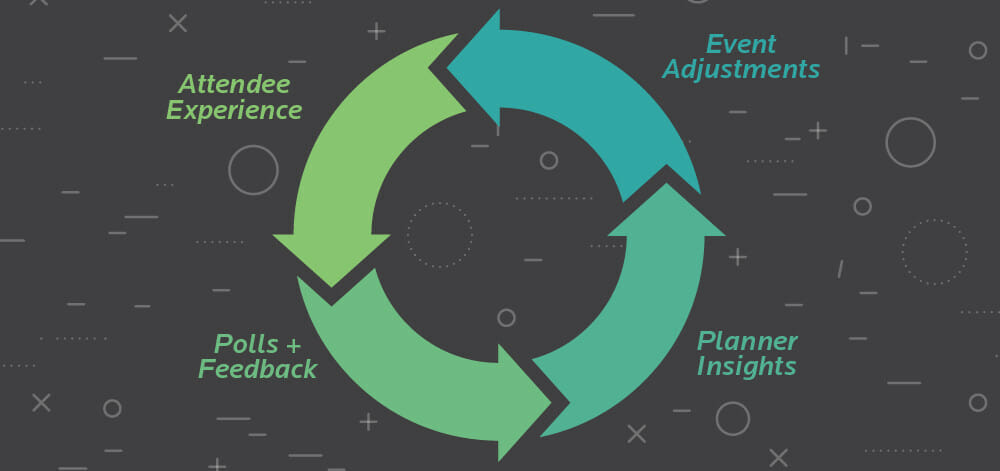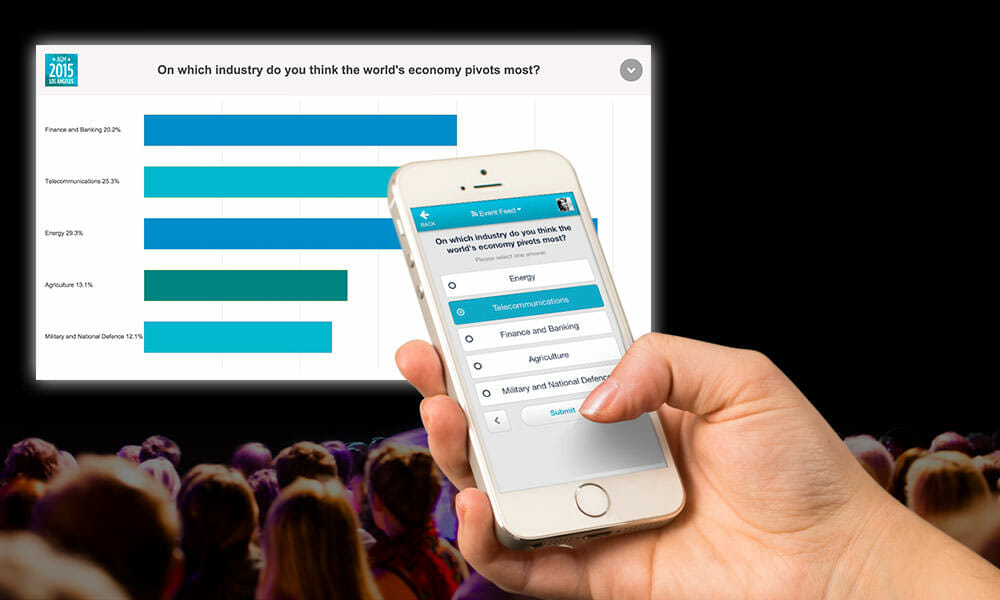Responsive Events: Designing the Experience Around Crowdsourced Content
Are you worried that you’re not delivering relevant content to your attendees? You’re not alone. Arranging speakers and choosing session topics 12 months in advance is one of the many challenges of event design. Delivering quality, up-to-date content to your attendees isn’t always as simple as highlighting trends, buzzworthy topics, or celebrity speakers. Attendees not only want to participate in the activity, but they also want to play a part in deciding what that activity is. Audience response technology allows planners to gather feedback in real time submitted from mobile devices rather than having to rely on cumbersome paper surveys.
Good Event Design Starts with Feedback
Responses and data collected from live polls, surveys, and Q&A features is a direct link between your event and your attendees. It offers a multitude of opportunities you can easily act on before, during and after the event. The insights gathered from feedback tools can be used to design better meetings, events, and attendee experiences making them as relevant and engaging as possible.
You can gather feedback throughout the entire event lifecycle. Prompting attendees to submit questions in the event app prior to the meeting will allow you to gear your content strategy to best answer those questions. During the event, gauge the quality of the learning experience with a live poll and make adjustments for the next day. When all’s said and done, a post-event survey can provide you with valuable insight into your audience’s satisfaction with the content, speakers, and style of sessions.
A big part of gathering quality feedback with your event app is having a good survey and poll question design. It’s important to remember that one question doesn’t give you one answer! When you ask a question, you get two valuable sources of insight for every survey: what the respondent said and how the respondent said it. Think beyond just the answer you see in front of you. When did they respond? Why did they seem to take so long? What device were they using? Asking one simple question can help you collect a vast amount of valuable data. The more data you can use as feedback, the better. If you don’t get the whole story, there will be an element of hypothesizing why a session or topic did well or not.
Taking Action on Insights
Encore Sessions
For example, you can see which sessions have the highest attendance and check which sessions are most valued based on session feedback on the event app. By referencing the data and feedback attendees freely submit, you can allocate time the following day for an encore of your most popular sessions. Use your conference’s app data and feedback together to tell more of a story about why a session was popular or not. Was it the time of day? the content? the speaker? the format? Note which topics are covered in encore sessions for future reference and which topics you should avoid when planning the next event.
The Unconference
The potential for this technology is not only reactionary, but it can also be used proactively to cater and focus the content covered in the whole event. The term used for events using this strategy is “unconferences.” Rather than following the conventional structure of scheduled programming, unconferences emphasize the informal exchange of information. With live polls and survey technology, you can crowdsource session topics before the event and incorporate what your attendees really want to hear about into your content strategy. The quality of the information will be hyper-focused and relevant to attendees because they will have played a part in deciding what’s covered. Your “unconference” app is vital to the success of your meeting, specifically the real-time communication tools that will keep your attendees in the know.
Crowdsourced Keynote
Keynote speeches tie together ideas and themes, effectively communicating the session takeaways and event themes. If the closing speech isn’t consistent with the rest of the event, there’s a chance it could misrepresent your event. Using an event app poll or session survey to ask attendees what they need clarification on or want to hear more about will let you fill in their blanks. Select a flexible keynote speaker to close the session and crowdsource topics using a Q&A feature, allowing for questions in the closing remarks. Showing your attendees how they’ve been heard will make a strong impact, bringing them deeper into the event experience.
With Smart Event Design, Show Your Attendees You’re Listening
Allowing your attendees, to drive the flow of content for a session, or for an entire conference, will minimize long-winded attendees bogarting your question period. Also, you’ll be able to collect useful data about content, speakers and session styles which you can use to plan future events. For example, by utilizing a live Q&A feature, C-level decision-makers are able to ask presenting scientists and engineers about the impact of smart grid technology. While the live curated Q&A provided an incredibly rich experience for attendees by allowing the audience to up-vote questions, the raw data was collected post-event and the unanswered questions created a framework for a future white-paper to be shared by the association.
Giving your attendees a voice establishes a trusted line of communication and fosters the relationship between attendee and event planner. Showing your attendees that you’re listening improves the conversation and bolsters current and future participation. By turning observations into opportunities to act, your event can adapt to your attendees preferences and adjust on the fly in productive and innovative ways.
Tune into Q&A
A global hotel client used the Q&A feature to put a creative twist on the traditional use-case when they allowed attendees to request songs for the DJ of the evening. With the results page set up at the DJ’s booth, staff members were able to easily send music requests directly to the DJ from the event app. Attendees were literally able to hear their suggestions playing on the speakers.
Let Your Audience Be the Judge
Build up your event by building up others. For example, organizers of an entrepreneurial event run a contest for five young people to pitch their ideas. Using live polling, attendees were able to anonymously vote for their favorite ideas. Winners then received funding based on the results of the live poll. This interactive element added a level of competition and showcased a creative use of the survey feature, which increased engagement during the event while supporting entrepreneurs.
How Polls and Wine Intertwine
This closing example serves to highlight an innovative way of taking advantage of audience response technology with a more comprehensive context. Barkley Kalpak Agency (BKA) is a New York-based team of strategists, designers, planners and producers that creates award-winning experiences for local and global clientele. For their own mid-year meeting, they used EventMobi and they were curious about all the different ways they could utilize mobile event apps to further customize their clients’ event experiences.
As a part of their evening program, BKA had a wine tasting session where staff could mingle, relax, and of course, enjoy regional wines. At the end of the evening, BKA used EventMobi’s polling feature to vote on the best wine — a fun way to share the experience, but that’s just where they got started.
With everyone’s votes neatly organized in the EventMobi system, the BKA management team extracted the data and delivered each person’s favorite bottle to their rooms the next day.
We’re not saying you have to deliver wine to everyone’s room! But, we encourage you to think creatively about what you can do with your data to add that unexpected value and wow your attendees.
Whether you’re gauging the effectiveness of a session, the general interest in a particular topic, or the biggest challenges attendees face, polling gives you valuable information that can help you design your meetings in the moment and in the future. For more information on how you can get event ideas with polls, surveys and feedback visit /audience-response/


